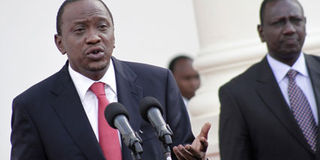What we see when we look to the ‘East’

PHOTO | EMMA NZIOKA | FILE President Uhuru Kenyatta and Deputy President William Ruto make a statement at State House Nairobi on July 4, 2013.
What you need to know:
- Kenya is central in the waters that host major sea-routes connecting Africa, the Middle East and East Asia with the Americas and Europe.
- Kenya will and must play its part – contributing and supporting diplomatic, military, humanitarian and political efforts as it has done in the past.
Throughout history, geography has played a tremendously influential role in global development, affecting the language, philosophy, culture, religion and economics of people and communities.
Notions of sovereignty are tightly interwoven with territorial delineations on the face of the earth. Geopolitics and geo-strategy are directly linked with geography.
It is not an exaggeration to state that geography drives wealth and poverty, war and peace, plight and prospects of the nations of the world. Never has this been more significant than it is now. Geography presents both daunting challenges, and incredible opportunities.
In 50 years of Kenya’s Independence, our location in the Greater Eastern Africa region – on the shores of the Indian Ocean – has subjected us to the turbulent energy of the Cold War as well as the “hot” conflicts that followed its thawing.
Before then, this location made pre-colonial and colonial Kenya an inevitable participant – willing or otherwise – in major global events, including the slave trade and the two World Wars.
The Cold War drove global superpowers to sponsor satellite and proxy states to bolster their hand in a competitive geopolitical power struggle.
The result was lavish material support for authoritarian governments who, in turn, consolidated tyranny and neglected service to their people. In the midst of post-Cold War upheaval, the winds of democratic change and economic renewal began to sweep across our region. Democratic consolidation and economic revival has firmly taken root.
East Africa and the greater Horn of Africa have for long been the arena of violence and instability. Fortunately, this chapter has largely drawn to a close. Of course, peace remains fragile in some parts, but there is a growing determination by the people of Africa to proactively build peace and prevent relapses into conflict and state collapse.
This has afforded the region’s peoples space to direct their energies to building stable and prosperous societies.
HUMAN HISTORY
The current chapter of our history unfolds in the context of the fastest sustained economic growth in human history. Asia, particularly the countries of the Indian Ocean Rim, comprising the Arabian Sea, the Bay of Bengal and the South China Sea, is the epicentre of this seismic economic phenomenon.
It is one of those boons of geography that Kenya straddles this rapidly emerging system of trade, investment and security.
Being able to exploit it economically, and working to make it stable and optimally conducive for commerce, is a core priority of our national interests now and in the future.
There are two cardinal pillars to this system, one of which is the foremost priority of my government: Being a leading participant in an integrating Africa that is shaping out as a globally indispensable source of raw and value-added materials for industries and consumers in Asia.
This is in addition to the traditional markets of Europe and North America. The East African Community integration has been accelerated and the Common Market for East and Southern Africa (Comesa) is on its way to becoming a free trade area. These regional blocs will be key drivers of Kenyan prosperity.
The other pillar is a rising Asia that rekindles memories of the ancient world economic system. This system revolved around the Indian Ocean as its hub and then, as now, the East African coast was an integral part. Kenya is central in the waters that host major sea-routes connecting Africa, the Middle East and East Asia with the Americas and Europe.
A secure Indian Ocean is key to global trade. Tankers plying its waters dominate the global trade in oil. For this reason, a secure Indian Ocean is critical to Asian economic development.
One-third of the world’s population lives near the Indian Ocean coastline. They inhabit countries which comprise the world’s fastest growing economies and megacities. Their growth is driving the rapid expansion of investment in Kenya, East Africa and Africa.
Trade will remain a defining feature of the Indian Ocean Rim dynamics for a long time. Measures taken to secure the Gulf of Aden and wrest the Horn of Africa coastline out of the grip of terror groups must be seen in this context. State failure is the direct cause of this insecurity. Peace-building is, therefore, indispensable to modern economic strategy.
Kenya will and must play its part – contributing and supporting diplomatic, military, humanitarian and political efforts as it has done in the past.
We are investing heavily in infrastructure to support our new role as a regional economic hub. This way, Kenya will act as an effective bridge to the opportunities in Africa and the Indian Ocean Rim.
This commitment will see Kenya become a partner, guarantor and beneficiary of peace and stability necessary to ensure the sustained prosperity of our neighbours and ourselves.
This commitment goes beyond China, where I will hold talks this week during my first State visit. China is important to our trade and investment and infrastructural development.
But so too are India and Singapore, Russia, Ukraine and Belarus, and others in the RIM and BRICS – such as Brazil and South Africa.
Writer is President of Kenya Twitter: @UKenyatta





